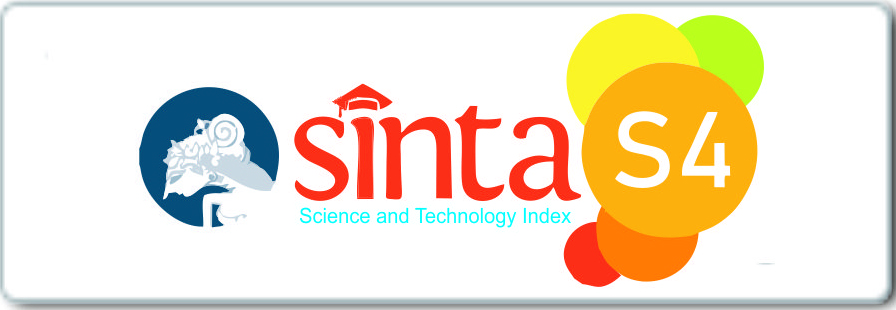Comparison of Tungsten Carbide and Arkansas Stone For Adhesive Removal On Enamel Surface After Debonding Procedure
Downloads
Background: Debonding aims to remove orthodontic appliances from the patient's teeth and cleanse all residual adhesive material on the surface of the tooth to restore surface conditions such as before orthodontic treatment. Damage may occur after debonding process. Removal of the remaining adhesive material has a major effect on the enamel surface conditions, the researcher wants to know the effect of cleaning adhesive material using Tungsten carbide 12 flute burs, Arkansas stone bur on the enamel surface Purpose: To determine the effect of cleaning the remaining adhesive material using Tungsten carbide 12 flute burs and Arkansas stone bur Against the Surface of the Enamel. Method: This study was experimental laboratory (in vitro study) with 4 groups division, first control group was tooth before bracket was installed, group 2 was done debonding without cleaning of residual adhesive, group 3 was done adhesive cleansing with Arkansas stone and group 4 was done adhesive cleaning with tungsten carbide 12-flutted Result: Showing that the use of 12-flutted tungsten carbide was able to clean enamel surfaces with the most delicate results and did not cause cracks or cracks on enamel surface Conclusions: The best method to clean the remaining adhesive is using 12-flutted tungsten carbide bur using contra angle high speed and with adequate water flow and sprays to prevent increasing of temperature that damage dental pup.
Michael B Olsen. 2011. The Effect Of Phosphoric Acid Etch In Conjunction With Self-Etching Primer On Enamel Surfaces And Resultant Orthodontic Bracket Bond Strength. Thesis. Oraland Craniofacial Sciences Master Degree. University of Missouri-Kansas City
Hasegawa A, Ikeda I, Kawaguchi S. (2012) Color and Translucency of in Vivo Natural Central Inci sors. J Prosthet Dent; 83:41-3.
Neelutpal Bora., Nabanita Baruah. (2015) Debonding in Orthodontics: A Review. University J Dent Scie, No. 1, Vol. 3
Hosein I, Sherriff M, Ireland AJ. (2014) Enamel loss during bonding, debonding, and cleanup with use of a self-etching primer. Am J Orthod Dentofacial Orthop; 126: 717-24.
Oliver RG. (2003). The Effect of Different Methods of Bracket Removal on the Amount of Residual Adhesive. Am J Orthod Dentofacial Orthop. 93(3): 196-200.
Cardoso, L. A. M., Valdrighi, H. C., Vedovello Filho, M., & Correr, A. B. (2014). Effect of adhesive remnant removal on enamel topography after bracket debonding. Dental Press Journal of Orthodontics, 19(6), 105–112.
Macieski, K., Rocha, R., Locks, A., & Ribeiro, G.U. (2011). Effects evaluation of remaining resin removal (three modes) on enamel surface after bracket debonding. Dental Press J Orthod, 14616(5), 146–154.
Zachrisson B, Arthun J. (1980): Enamel Surface after Various Debonding Procedures. Am J Orthod: 1980:75 (2):12 1-137.
Joanna J.O., Tomasz S. (2014) Effect of Orthodontic Debonding and Adhesive Removal on the Enamel – Current Knowledge and Future Perspectives – a Systematic Review, Med Sci Monit. 2014; 20: 1991-2001.
Grocholewicz, K. (2014). Effect of Orthodontic Debonding and Adhesive Removal on the Enamel – Current Knowledge and Future Perspectives – a Systematic Review. Medical Science Monitor, 20, 1991–2001.
Buonocore MG, Wileman WR, Brudevold F. (1960) A Simple Method of Increasing The Adhesion Of Acrylic Filling Materials To Enamel Surfaces. J Dent Res.; 33:694
Ryf, S., Flury, S., Palaniappan, S., Lussi, A., Van Meerbeek, B., & Zimmerli, B. (2012). Enamel loss and adhesive remnants following bracket removal and various clean-up procedures in vitro. European Journal of Orthodontics, 34(1), 25–32.
Ahrari, F., Akbari, M., Akbari, J., & Dabiri, G. (2013). Enamel surface roughness after debonding of orthodontic brackets and various clean-up techniques. Journal of Dentistry (Tehran, Iran), 10(1), 82–93. Retrieved
Kitayama, S., Nikaido, T., Ikeda, M., Foxton, R. M., & Tagami, J. (2007). Enamel bonding of self- etch and phosphoric acid-etch orthodontic adhesive systems. Dental Materials Journal, 26(1), 135– 143.
This is an open access journal, and articles are distributed under the terms of the Creative Commons Lisence, which allows others to remix, tweak, and build upon the work non-commercially, as long as appropriate credit is given and the new creations are licensed under the identical terms.
Copyright notice:
IJDM by UNAIR is licensed under a Creative Commons Atribusi 4.0 Internasional.
- The journal allows the author to hold the copyright of the article without restrictions.
- The journal allows the author(s) to retain publishing rights without restrictions.
- The legal formal aspect of journal publication accessibility refers to Creative Commons Attribution (CC BY)
















